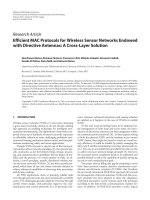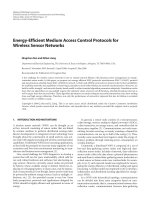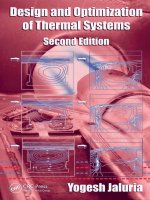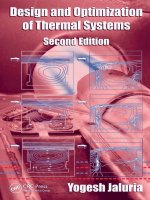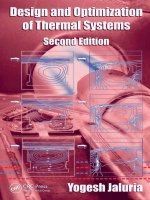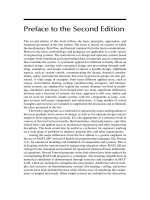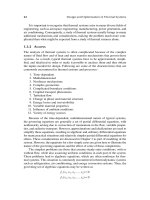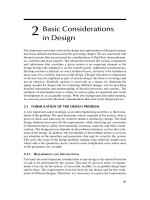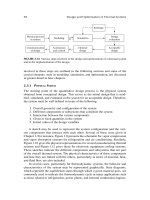Analysis, design and optimization of energy efficient protocols for wireless sensor networks
Bạn đang xem bản rút gọn của tài liệu. Xem và tải ngay bản đầy đủ của tài liệu tại đây (2.66 MB, 218 trang )
ANALYSIS, DESIGN AND OPTIMIZATION OF
ENERGY EFFICIENT PROTOCOLS FOR WIRELESS
SENSOR NETWORKS
HOANG DUC CHINH
NATIONAL UNIVERSITY OF SINGAPORE
2013
ANALYSIS, DESIGN AND OPTIMIZATION OF
ENERGY EFFICIENT PROTOCOLS FOR WIRELESS
SENSOR NETWORKS
HOANG DUC CHINH
(B.Eng., Hanoi University of Technology, Vietnam)
A THESIS SUBMITTED
FOR THE DEGREE OF DOCTOR OF PHILOSOPHY
DEPARTMENT OF ELECTRICAL AND COMPUTER
ENGINEERING
NATIONAL UNIVERSITY OF SINGAPORE
2013
DECLARATION
I hereby declare that the thesis is my original work and it has been
written by me in its entirety. I have duly acknowledged all the sources of
information which have been used in the thesis.
This thesis has also not been submitted for any degree in any university
previously.
_________________
Hoang Duc Chinh
29 August 2013
Acknowledgments
I wishes to record my deep sense of gratitude to my supervisor, Assoc. Prof.
Sanjib Kumar Panda, who has introduced the present area of work and guided
in this work. My thesis supervisor, Assoc. Prof. Sanjib Kumar Panda has been
a source of incessant encouragement and patient guidance throughout the thesis
work. I am extremely grateful and obliged to Dr. Rajesh Kumar for his intellectual
innovative and highly investigative guidance to me for my project. I wish to express
my warm and sincere thanks to the laboratory officers, Mr. Y. C. Woo, and
Mr. M. Chandra of Electrical Machines and Drives Lab. NUS, for their readiness
to help on any matter. The author’s warmest thanks go to the fellow research
scholars in Electrical Machines and Drives Lab for all the help to make my stay
more enjoyable and beneficial. The author wishes to convey special thanks to Dr.
Yen Kheng Tan, Mr. Parikshit Yadav for their valuable discussions on the design
and development of my project and their constant help and suggestions in many
aspects of my research works. My heartfelt gratitude goes to Dr. Haihua Zhou, Dr.
Satyanarayan Bhuyan, Dr. S.K. Sahoo, Mr. Bhuneshwar Prasad and Krishnanand
Kaippilly Radhakrishnan for their supportive and inspiring comments during my
study.
I owes so much appreciation for many warm-hearted, and wonderful friends
i
inside and outside of the NUS campus. Thanks to my old classmates, Nam Hoai
Pham, Dr. Xuan Loc Nguyen, Dr. Thanh Long Vu, Tran Duong, Van Nghiem,
Hoa Nguyen and Tuan Dung Phan for their encouragement and help for my PhD
application. I am truely grateful to Muraliraj S/O Rajoo Devaraj and Ching Kuan
Thye for their help to develop the software design of my project. I would like to
say thank to Hien Nguyen, Hien La for their help to proofread my thesis. Also, I
will cherish the friendship with Son Le, Luong Ha, Nghia Cao and Huong Nguyen
and all the friends who take care of me and support me.
I have been deeply touched by endless love and boundless support by my
family. I would like to thank to my sister, Kieu Ngan Hoang, my cousin, Thanh
Dinh Khac, my grand mother, Le Bui, my grand father, Phach Dinh Khac, and
my fiancee, Chuc Nguyen Thanh for all their love and support. I am indebted to
my parents, Lan Dinh Thuy and Binh Hoang Duc, for everything that they have
given to me. They have stood by me in everything I have done, providing constant
support, encouragement, and love. I wish to dedicate this thesis for their love and
support.
ii
Contents
Summary x
List of Tables xv
List of Figures xviii
List of Symbols xxv
Acronyms xxvii
1 Introduction 1
1.1 Basis of Wireless Sensor Networks . . . . . . . . . . . . . . . . . . . 2
1.1.1 Composition of single nodes . . . . . . . . . . . . . . . . . . 4
1.1.2 Communication protocols . . . . . . . . . . . . . . . . . . . 7
iii
1.2 Motivation . . . . . . . . . . . . . . . . . . . . . . . . . . . . . . . . 9
1.3 Problem Statement . . . . . . . . . . . . . . . . . . . . . . . . . . . 12
1.3.1 Energy conservation mechanisms for small scale WSNs . . . 13
1.3.2 Improvement of the network formation of cluster-based WSNs 15
1.3.3 Optimization of network formation and cluster head selection
with nature-inspired optimization methods . . . . . . . . . . 16
1.3.4 Optimal construction of data aggregation tree . . . . . . . . 17
1.4 Contributions of the Thesis . . . . . . . . . . . . . . . . . . . . . . 19
1.5 Thesis Organisation . . . . . . . . . . . . . . . . . . . . . . . . . . . 21
2 Energy Efficient Routing and Optimization Methods in Wireless
Sensor Networks 24
2.1 Introduction . . . . . . . . . . . . . . . . . . . . . . . . . . . . . . . 24
2.2 Routing Protocols for Wireless Sensor Networks . . . . . . . . . . . 27
2.2.1 Overview of routing protocols in WSNs . . . . . . . . . . . . 27
2.2.2 Classification and Operation of routing protocols in WSNs . 29
iv
2.3 Optimization Methods for Energy Efficient Routing Protocols . . . 34
2.3.1 Clustering Algorithms for cluster-based protocols . . . . . . 34
2.3.2 Nature-inspired Optimization Methods . . . . . . . . . . . . 38
2.4 Conclusions . . . . . . . . . . . . . . . . . . . . . . . . . . . . . . . 42
3 WSNs Systems Model and Analysis 43
3.1 Introduction . . . . . . . . . . . . . . . . . . . . . . . . . . . . . . . 43
3.2 Wireless Sensor Nodes’ Energy Model and Cluster Head Rotation
for Balancing Energy . . . . . . . . . . . . . . . . . . . . . . . . . . 43
3.2.1 Energy Model of the Wireless Sensor Node . . . . . . . . . . 43
3.2.2 Cluster Head Rotation for Balancing Energy in Wireless Sen-
sor Nodes . . . . . . . . . . . . . . . . . . . . . . . . . . . . 45
3.3 A Single Sensor Node Hardware System . . . . . . . . . . . . . . . 48
3.3.1 Sensor Node Energy Consumption . . . . . . . . . . . . . . . 48
3.3.2 Sensor Node with Thermoelectric Generator . . . . . . . . . 52
3.4 Power Management in Real-time Wireless Sensor Networks . . . . . 61
v
3.4.1 Transmission Power Level Configuration for Wireless Sensor
Nodes . . . . . . . . . . . . . . . . . . . . . . . . . . . . . . 61
3.4.2 Intra-cluster Power Management for Wireless Sensor Networks 65
3.5 Conclusions . . . . . . . . . . . . . . . . . . . . . . . . . . . . . . . 80
4 A Cluster-based Protocol for Wireless Sensor Networks using Fuzzy
C-means Protocol 81
4.1 Introduction . . . . . . . . . . . . . . . . . . . . . . . . . . . . . . . 81
4.2 Preliminaries . . . . . . . . . . . . . . . . . . . . . . . . . . . . . . 82
4.2.1 Network Assumptions . . . . . . . . . . . . . . . . . . . . . 82
4.2.2 Energy Consumption of Cluster-based WSNs . . . . . . . . . 83
4.3 Fuzzy C-Means Algorithm . . . . . . . . . . . . . . . . . . . . . . . 85
4.4 Simulation of FCM cluster-based WSNs . . . . . . . . . . . . . . . 89
4.4.1 Experiment 1 - Network lifetime assessment with different
protocols . . . . . . . . . . . . . . . . . . . . . . . . . . . . . 89
4.4.2 Experiment 2 - Energy consumption evaluation within the
deployment network . . . . . . . . . . . . . . . . . . . . . . 94
vi
4.5 Design and Implementation of the protocol in a hardware platform 96
4.6 Network and Sensor node configuration . . . . . . . . . . . . . . . . 102
4.7 Experimental Results . . . . . . . . . . . . . . . . . . . . . . . . . . 105
4.8 Conclusions . . . . . . . . . . . . . . . . . . . . . . . . . . . . . . . 110
5 Harmony Search Algorithm based Clustering Protocols 111
5.1 Introduction . . . . . . . . . . . . . . . . . . . . . . . . . . . . . . . 111
5.2 Optimization Problem of the WSNs . . . . . . . . . . . . . . . . . . 112
5.3 Harmony Search Algorithm . . . . . . . . . . . . . . . . . . . . . . 114
5.4 A Harmony Search Algorithm based Clustering Protocol . . . . . . 117
5.5 Simulation Results and Discussions . . . . . . . . . . . . . . . . . . 119
5.5.1 Convergence comparison . . . . . . . . . . . . . . . . . . . . 119
5.5.2 Network performance . . . . . . . . . . . . . . . . . . . . . . 121
5.6 Real-time Implementation of the HSACP for WSN . . . . . . . . . 122
5.7 Experimental Results . . . . . . . . . . . . . . . . . . . . . . . . . . 125
vii
5.7.1 Experiment Setup . . . . . . . . . . . . . . . . . . . . . . . . 125
5.7.2 Investigation of the convergence and computational time . . 125
5.7.3 Experimental results of the network performance . . . . . . 128
5.8 Conclusions . . . . . . . . . . . . . . . . . . . . . . . . . . . . . . . 132
6 Energy Efficient Multihop Communication for Large Scale WSNs
using Intelligent Water Drops Algorithm 134
6.1 Introduction . . . . . . . . . . . . . . . . . . . . . . . . . . . . . . . 134
6.2 Optimization Problem and Network Assumptions . . . . . . . . . . 136
6.3 Principles of Intelligent Water Drops Algorithm . . . . . . . . . . . 139
6.4 Optimal Data Aggregation Tree Formation of WSNs using Intelli-
gent Water Drops Algorithm . . . . . . . . . . . . . . . . . . . . . . 143
6.4.1 Constructing aggregation tree with Intelligent Water Drop
(IWD) algorithm . . . . . . . . . . . . . . . . . . . . . . . . 143
6.4.2 Improvement of the IWD algorithm for searching the aggre-
gation nodes . . . . . . . . . . . . . . . . . . . . . . . . . . . 149
6.5 Computational Experimental Results and Discussions . . . . . . . . 151
viii
6.6 Conclusion . . . . . . . . . . . . . . . . . . . . . . . . . . . . . . . . 159
7 Conclusions and Future Works 161
7.1 Conclusions . . . . . . . . . . . . . . . . . . . . . . . . . . . . . . . 161
7.2 Future works . . . . . . . . . . . . . . . . . . . . . . . . . . . . . . 166
Publications 168
Bibliography 170
ix
Summary
The recent advances in information and communication technologies enable fast
development and practical applications of wireless sensor networks (WSNs). The
operation of the WSNs including sensing and communication tasks needs to be
planned properly in order to achieve the application-specific objectives. The WSNs
consist of a number of sensor nodes equipped with microprocessor, wireless transceiver,
sensing components and energy source. These sensor nodes operate as autonomous
devices to perform different tasks including sensing, communication and data pro-
cessing. As the members of a network, the sensor nodes are required to cooperate
with each other to perceive environmental parameters and transfer data.
Commonly, the sensor nodes are left unattended in the environment after
being deployed with limited resources such as computational ability, memory and
energy. In order to serve for a long lifespan, the resources, especially energy, need
to be utilized appropriately. Efficient energy usage is an essential requirement for
each individual node as well as for the overall network.
A number of energy efficient protocols have been proposed in the literature.
The cluster-based protocol is one classification which has the advantage of scal-
ability, efficient communication and energy savings. This protocol organizes the
x
network into clusters, each cluster has one cluster head (CH) that gathers and ag-
gregates data from all the cluster members, and then send to a base station (BS).
Hence, the amount of transferred data is reduced that conserves the energy. The
tree-based protocol is another type of protocols that supports multihop commu-
nication. Energy efficiency may not be as high as the cluster-based protocol, but
it may be the more suitable option when the sensor nodes’ communication range
is not large enough to reach the destination, i.e. the BS, in one hop. In both of
these protocols, data aggregation is an essential technique that enables significant
decrease of data packets being sent and save large amount of energy consumption
for data transfer. Optimization methods have been applied to improve the per-
formance of these protocols during the organization of the network, i.e. cluster
formation and cluster head selection in cluster-based protocols or tree construction
and aggregation node selection in tree-based protocols. However, in some of the
methods, only local optimum can be achieved. Furthermore, most of the protocols
using optimization algorithms are investigated in simulation and not yet developed
for real-life applications.
This thesis analyses the power consumption of wireless sensor nodes in prac-
tice for performing different tasks. The energy sources for sustaining the sensor
nodes operation are also investigated. These sources include renewable energy
sources like a thermal energy harvesting source and finite energy source like bat-
tery. The energy aware CH selection scheme for a small scale WSN consisting of
one cluster is developed and evaluated in both simulation and real-time operation.
For a larger scale WSNs, three energy efficient protocols are proposed in
this thesis. First, a Fuzzy C-Means cluster-based protocol (FCMCP) is designed
xi
in order to achieve a more uniform formation of clusters when compared to a
typical cluster-based protocol such as LEACH. The FCMCP adopts Fuzzy C-Means
(FCM) algorithm to organize sensor nodes into cluster with the expectation that the
mean distances between these nodes and the centroid of each cluster is minimized.
Therefore, the number of send nodes in each cluster is more equal, and traffic load
is balanced at the CH, and the communication distance of the cluster members
is reduced, which means less energy consumption for data transfer is required.
Second, further improvements in the Fuzzy C-Means cluster-based protocol are
carried out with the consideration of energy awareness into the cluster formation
and cluster head selection. An objective function that attempts to optimize the
mean distance of each cluster from its sensor nodes and simultaneously selects the
best CH in terms of energy efficiency is formulated. In order to solve this problem
efficiently, a novel evolutionary algorithm, called Harmony Search Algorithm (HSA)
is adopted. The HSA mimics the process of improvising music. It is able to
obtain the best fitness value with fast convergence in this problem when compared
to other evolutionary algorithms such as Genetic Algorithm (GA) and Particle
Swarm Optimization (PSO). A general framework is also proposed for designing
and implementation of the centralized cluster-based protocols for real-time WSNs
with the support of various optimization methods. It is later applied to develop
the cluster based protocols using FCM and HSA, called FCMCP and HSACP, on a
hardware test-bed. The experiments are conducted to validate the energy efficiency
and the ability of extending network lifetime of these two protocols.
Third, a tree-based protocol is proposed with the adoption of the nature-
inspired optimization method, called Intelligent Water Drops (IWD) algorithm.
The IWD algorithm imitates the flow of water drops in the streams or rivers that
xii
attempt to find the shortest way with fewer obstacles to reach the destinations like
lakes or oceans. It is similar in the case of WSNs when data packets generated
from some data source nodes look for the best routes that lead to the sink or base
station. When being applied in the WSN, IWD algorithm optimally establishes a
data aggregation tree that consists of minimum number of nodes with the aggrega-
tion nodes chosen as near to the data sources as possible. An improvement of the
basic IWD algorithm is also carried out that can enhance the probability of finding
the best aggregation nodes. The evaluation of the tree-based protocol using IWD
is performed in simulation and compared with a well-known nature-inspired opti-
mization method called Ant Colony Optimization (ACO). It is shown that with the
application of IWD, the energy consumption for transferring data can be reduced
and the network lifetime can be extended.
The computational as well as experimental results presented in the thesis
have proved the better performance of the WSNs, i.e. longer network lifetime,
when the proposed energy conservation mechanisms and energy efficient protocols
are employed. It is also shown that the proposed centralized cluster-based protocols
like FCMCP and HSACP are able to be practically implemented and operate the
real-time WSNs efficiently.
At this stage, the study of network operation mainly focus on lifetime exten-
sion. However, the quality of service (QoS) is also required. Consideration of QoS
introduces more dimensions to the optimization problems of the WSN that needs to
be further investigated. Supporting services like localization have not been studied.
The implementation of localization service enables fully autonomous operation of
the sensor node. However, it also requires more resources, thus efficient methods
xiii
need to be developed. The renewable energy sources is investigated in the thesis for
individual nodes. Incorporation of these sources in the operation of the proposed
protocols have not been done and is left for the future work. In additions, the
investigation of a protocol using IWD algorithm for real-time operation can be also
carried out in the future work.
xiv
List of Tables
1.1 OSs for WSNs and their specifications . . . . . . . . . . . . . . . . 7
2.1 Typical clustering algorithms . . . . . . . . . . . . . . . . . . . . . 36
3.1 Example current consumption and related characteristics of sensors
[102] . . . . . . . . . . . . . . . . . . . . . . . . . . . . . . . . . . . 49
3.2 Operation modes of the sensor node’s components . . . . . . . . . . 50
3.3 The relationship between RSSI and efficient distance for communi-
cation . . . . . . . . . . . . . . . . . . . . . . . . . . . . . . . . . . 64
3.4 Power consumption of the network with and without adjusting power
transmission level . . . . . . . . . . . . . . . . . . . . . . . . . . . . 66
3.5 Corresponding scenario and environmental conditions . . . . . . . . 75
3.6 Setting Values for WSN Experiment . . . . . . . . . . . . . . . . . . 76
xv
3.7 Summary of lifetime for N = 3 & N = 6 . . . . . . . . . . . . . . . 80
4.1 Duration of time up to the first node dies in the network . . . . . . 93
4.2 Transmission power level settings with respect to distances for at
least 90% successful transmission. . . . . . . . . . . . . . . . . . . . 105
4.3 Setting Values for WSN Experiment . . . . . . . . . . . . . . . . . . 106
4.4 Comparison of network lifetime, t
first
and t
last
in hours when the
number of sensor node deployed varies . . . . . . . . . . . . . . . . 109
5.1 Duration of time up to the first node dies in the network . . . . . . 121
5.2 Setting Values for Wireless Sensor Network (WSN) Experiment . . 127
5.3 Computational time and setup phase duration . . . . . . . . . . . . 128
6.1 Message format of an IWD packet. . . . . . . . . . . . . . . . . . . 144
6.2 Simulation parameters. . . . . . . . . . . . . . . . . . . . . . . . . . 151
6.3 IWD algorithm parameters. . . . . . . . . . . . . . . . . . . . . . . 152
6.4 The total hop count of data aggregation tree . . . . . . . . . . . . . 158
xvi
6.5 The average computational time, in (second), per iteration taken by
different algorithms . . . . . . . . . . . . . . . . . . . . . . . . . . . 159
xvii
List of Figures
1.1 Sensor nodes deployed in the environment . . . . . . . . . . . . . . 2
1.2 Typical architecture of a sensor node . . . . . . . . . . . . . . . . . 4
1.3 An example of programming model for Sensor Nodes (adapted from
[8]) . . . . . . . . . . . . . . . . . . . . . . . . . . . . . . . . . . . . 6
1.4 Hardware Abstraction Architecture in OS for WSN (adapted from
[10]) . . . . . . . . . . . . . . . . . . . . . . . . . . . . . . . . . . . 7
1.5 Network protocol stack in Zigbee Standard (adapted from [13]) . . . 9
3.1 Sensor Node Components and Energy Consumption for Data Ag-
gregation and Communication Task . . . . . . . . . . . . . . . . . . 44
3.2 Residual energy levels of the conventional fixed gateway and the
selective gateway . . . . . . . . . . . . . . . . . . . . . . . . . . . . 47
3.3 Gateway life time with different number of nodes in the network . . 47
xviii
3.4 Operation modes of a sensor node’s main components . . . . . . . . 51
3.5 Wireless Body Area Network Architecture in Medical Healthcare
System . . . . . . . . . . . . . . . . . . . . . . . . . . . . . . . . . . 53
3.6 Thermal analysis of the thermoelectric generator (TEG) . . . . . . 54
3.7 Prototype of the thermoelectric generator (TEG) . . . . . . . . . . 56
3.8 Schematic diagram of thermal energy harvesting sensor node for fall
detection . . . . . . . . . . . . . . . . . . . . . . . . . . . . . . . . . 57
3.9 Sensing of Body Posture (Stand and Fall) using H34C . . . . . . . . 58
3.10 Voltage adaptation circuitry for calibrating accelerometer output
voltage . . . . . . . . . . . . . . . . . . . . . . . . . . . . . . . . . . 58
3.11 Power generated by TEG for various loading conditions . . . . . . . 59
3.12 Fall detection signal received at base station . . . . . . . . . . . . . 60
3.13 Transmission power levels of the transceiver ATmel AT86RF230 . . 62
3.14 Test-bed for the measurement of current consumption at different
transmission power levels . . . . . . . . . . . . . . . . . . . . . . . . 63
3.15 Variation of current consumption over transmission power level . . . 64
xix
3.16 Percentage of successful transmission at different transmission power
level when changing the distance to receive node . . . . . . . . . . . 65
3.17 N hops linear network . . . . . . . . . . . . . . . . . . . . . . . . . 65
3.18 Nodes’ deployment with the cluster of N = 3 and N = 6 . . . . . . 66
3.19 The relationship between a fully-charged AA size NiMH battery’s
voltage and its percentage of capacity discharged, as obtained ex-
perimentally . . . . . . . . . . . . . . . . . . . . . . . . . . . . . . . 68
3.20 The sensing and radio operations intervals for both CH and CM nodes 70
3.21 The display of data received at the base station . . . . . . . . . . . 78
3.22 Number of alive nodes over time with the cluster of N = 3 nodes . . 79
3.23 Number of alive nodes over time with the cluster of N = 6 nodes . . 79
4.1 The operation of the WSN using FCM. . . . . . . . . . . . . . . . . 86
4.2 Deployment of sensor nodes into monitored field . . . . . . . . . . . 90
4.3 Cluster formation with LEACH protocol at a arbitrary round . . . 91
4.4 Cluster formation with FCMCP . . . . . . . . . . . . . . . . . . . . 91
xx
4.5 Distribution of dead nodes (dots) with Direct Communication after
300 rounds . . . . . . . . . . . . . . . . . . . . . . . . . . . . . . . 92
4.6 Distribution of dead nodes (dots) with Minimum Transmission En-
ergy (MTE) after 300 rounds . . . . . . . . . . . . . . . . . . . . . 92
4.7 Distribution of dead nodes (dots) with Low Energy Adaptive Clus-
tering Hierarchy (LEACH) after 700 rounds . . . . . . . . . . . . . 92
4.8 Distribution of dead nodes (dots) with Fuzzy C-Means (FCM) after
1600 rounds . . . . . . . . . . . . . . . . . . . . . . . . . . . . . . . 92
4.9 Number of node alive over the time with different cluster based pro-
tocols . . . . . . . . . . . . . . . . . . . . . . . . . . . . . . . . . . 93
4.10 Average energy dissipated within the network over the network di-
ameter after 200 rounds . . . . . . . . . . . . . . . . . . . . . . . . 95
4.11 Average energy dissipated within the network by using MTE and
[ (FCMCP) over the network diameter and electronics energy after
200 rounds . . . . . . . . . . . . . . . . . . . . . . . . . . . . . . . . 95
4.12 Average energy dissipated within the network by using LEACH and
FCMCP over the network diameter and electronics energy after 200
rounds . . . . . . . . . . . . . . . . . . . . . . . . . . . . . . . . . . 95
xxi
4.13 Average energy dissipated within the network by using K-Means and
FCMCP over the network diameter and electronics energy after 200
rounds . . . . . . . . . . . . . . . . . . . . . . . . . . . . . . . . . . 95
4.14 Diagram of the routing frame work for a centralized cluster-based
protocol. . . . . . . . . . . . . . . . . . . . . . . . . . . . . . . . . . 97
4.15 Main components of the routing layer. . . . . . . . . . . . . . . . . 98
4.16 The time schedule of the network operation . . . . . . . . . . . . . 99
4.17 The structure of an advertisement message . . . . . . . . . . . . . . 100
4.18 The structure of an assignment message . . . . . . . . . . . . . . . 100
4.19 Network deployment in the environment. . . . . . . . . . . . . . . . 102
4.20 The structure of data aggregation packet sent by the CH . . . . . . 103
4.21 Measurement of the sensor nodes current consumption in different
phases. . . . . . . . . . . . . . . . . . . . . . . . . . . . . . . . . . . 107
4.22 Network lifetime with LEACH-C and FCMCP . . . . . . . . . . . . 109
5.1 Convergence of the objective function . . . . . . . . . . . . . . . . . 120
5.2 Number of alive node vs. time . . . . . . . . . . . . . . . . . . . . . 122
xxii
